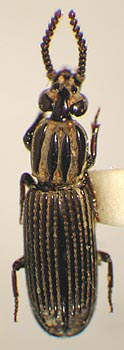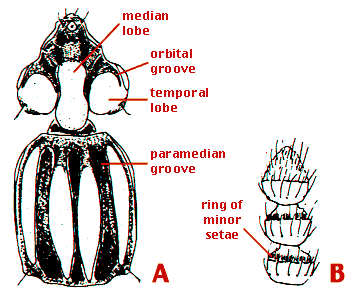Kaveinga
Ross T. BellIntroduction
Kaveinga is the largest genus in the subtribe Rhysodina. There are 22 species in four subgenera. They inhabit the Southwest Pacific area, including New Guinea, Australia, New Zealand, New Caledonia, the Solomon Islands, Mindanao, and Sulawesi.
A key to the subgenera of Kaveinga is available here.
Characteristics
The antennal stylet is absent, except in one species. There are minor setae on antennomeres VI-X; in a few species, they are confined to the more distal segments. The medial margins of the temporal lobes are curved or oblique; they do not closely parallel the margins of the median lobe. The orbital groove, if present, is terminated at the posterior margin of the eye. In most species, the pronotum has complete paramedian grooves. In two species, these are represented anteriorly by very coarse puncture rows which fail to reach the anterior margin. The prosternum has precoxal carinae. The humeral tubercle is well developed. The middle and hind tibiae each have only one spur.
References
Bell, R. T. and J. R. Bell. 1979. Rhysodini of the World part II. Revisions of the smaller genera (Coleoptera: Carabidae or Rhysodidae). Quaestiones Entomologicae 15: 377-446.
Title Illustrations

| Scientific Name | Kaveinga (K.) abbreviata |
|---|---|
| Location | Australia: Queensland, Upper Little Mulgrave River |
| Specimen Condition | Dead Specimen |
| Identified By | R. T. Bell |
| Collection | CAS |
| Image Use |
 This media file is licensed under the Creative Commons Attribution License - Version 3.0. This media file is licensed under the Creative Commons Attribution License - Version 3.0.
|
| Copyright |
© 2000 David R. Maddison

|
About This Page
Ross T. Bell

University of Vermont, Burlington, Vermont, USA
Page copyright © 2000 Ross T. Bell
All Rights Reserved.
- First online 01 March 2000
Citing this page:
Bell, Ross T. 2000. Kaveinga. Version 01 March 2000 (under construction). http://tolweb.org/Kaveinga/2238/2000.03.01 in The Tree of Life Web Project, http://tolweb.org/









 Go to quick links
Go to quick search
Go to navigation for this section of the ToL site
Go to detailed links for the ToL site
Go to quick links
Go to quick search
Go to navigation for this section of the ToL site
Go to detailed links for the ToL site